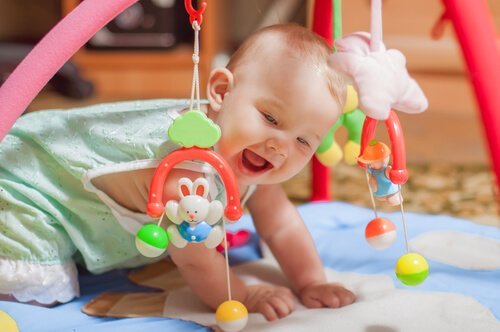How to Make Your Home Safe for Children


Written and verified by the psychopedagogue María José Roldán
A large percentage of the world’s accidents involving children occur in the home. This makes sense, since it’s where they spend most of their time. How can you make your home safe for little ones? It’s a matter of taking the necessary precautions to prevent our children from suffering incidents at home.
Precaution: Risks are everywhere
While the risks are present everywhere when it comes to dynamic or extremely active children, some places are more dangerous than others.
For example, kitchens and bathrooms are more prone to the accumulation of grease and moisture. Likewise, stairs, balconies, doors and windows must include safety measures in order to protect children.
When infants start to crawl, danger starts to grow. It’s time to increase safety measures to guarantee happy development and a healthy life. To make your home safe for children, put the following recommendations into practice.
How to make your home safe for children?
First of all, supervision is key when planning how to make your home safe for little ones. There must alway be a supervising adult who is attentive to a child’s movements in order to prevent household accidents.
In the kitchen and the bathroom: Only under supervision
It’s best for children not to play in the kitchen, where there are dangers like heat, knives and heavy objects, all within reach. If this is unavoidable, then you need to consider options like no-slip and anti-bacterial flooring.
You should never leave an unwatched pot on the stove or let your little one near a hot stove. Furthermore, you should never leave an iron plugged in, especially when your child is near.
As for the bathroom, children must always have adult supervision. It’s important to keep the toilet lid down and keep children away from receptacle areas where they can drown. Keep in mind that children can drown in very little water.
Never home alone
Children should never be home alone. No matter how little time an adult is absent from the home, there will always be a real danger.
It’s important to plan well and call on the help of friends and family if needed. If you have no other choice, then take your little one along with you or change your plans.
Just the same, certain electronic devices, such as fans, irons, heaters need to be out of reach. Children are extremely curious and are unable to foresee risks or consequences. It’s extremely important for adults to keep dangerous objects high up and out of children’s reach.
Be careful with cords and plugs
Another very important aspect is being safe with cords and plugs. Children may be drawn to these objects and touch or even bite cords that are within their reach. Also keep in mind the possibility of them putting their fingers or other objects into wall sockets.
You can find special tubes on the market to cover defective cords, and safety covers for electrical outlets. Under no circumstances whatsoever should children be allowed to touch cords, plugs or outlets.
Lit candles, sharp objects and medications should also be out of reach of children at all times. Cleaning products, which are often colorful and bright, are another real risk. Many children end up in the hospital after having infested toxic cleaning products they found in their homes.
Everything ends up in their mouths
Small objects are easy for children to manipulate and swallow. Therefore, they’re another major risk in the home.
Little ones tend to put anything they find into their mouths. This is their way of getting to know the world around them. However, it can also put them in danger of choking and intoxication.
“When infants start to crawl, danger starts to grow. It’s time to increase safety measures to guarantee happy development and a healthy life”
Safety gates and railings
Setting up baby gates and railings around staircases is an essential safety measure. When babies start to crawl, they want to experience new things.
Stairs are often at the top of their list. Keeping little ones away from balconies, doorways, easily opened windows and staircases is a must.
Parents also need to be on alert for sharp furniture edges, such as the corners of tables and chairs. In general, these tend to be right at the height of a little one’s head, making bumps and bruises a big risk.

Be careful with toys
Toys tossed all over the house can also cause accidents. Picking them up along with your little one will help minimize risks and give you a fun activity to share. Involving your little one in the task will help instill safety and responsibility at an early age.
60% of accidents involving children under the age of 5 occur in the home. Prevention is a tedious task, but it’s absolutely necessary.
Following the above safety measures will help you make your home safe for children to grow and develop.
A large percentage of the world’s accidents involving children occur in the home. This makes sense, since it’s where they spend most of their time. How can you make your home safe for little ones? It’s a matter of taking the necessary precautions to prevent our children from suffering incidents at home.
Precaution: Risks are everywhere
While the risks are present everywhere when it comes to dynamic or extremely active children, some places are more dangerous than others.
For example, kitchens and bathrooms are more prone to the accumulation of grease and moisture. Likewise, stairs, balconies, doors and windows must include safety measures in order to protect children.
When infants start to crawl, danger starts to grow. It’s time to increase safety measures to guarantee happy development and a healthy life. To make your home safe for children, put the following recommendations into practice.
How to make your home safe for children?
First of all, supervision is key when planning how to make your home safe for little ones. There must alway be a supervising adult who is attentive to a child’s movements in order to prevent household accidents.
In the kitchen and the bathroom: Only under supervision
It’s best for children not to play in the kitchen, where there are dangers like heat, knives and heavy objects, all within reach. If this is unavoidable, then you need to consider options like no-slip and anti-bacterial flooring.
You should never leave an unwatched pot on the stove or let your little one near a hot stove. Furthermore, you should never leave an iron plugged in, especially when your child is near.
As for the bathroom, children must always have adult supervision. It’s important to keep the toilet lid down and keep children away from receptacle areas where they can drown. Keep in mind that children can drown in very little water.
Never home alone
Children should never be home alone. No matter how little time an adult is absent from the home, there will always be a real danger.
It’s important to plan well and call on the help of friends and family if needed. If you have no other choice, then take your little one along with you or change your plans.
Just the same, certain electronic devices, such as fans, irons, heaters need to be out of reach. Children are extremely curious and are unable to foresee risks or consequences. It’s extremely important for adults to keep dangerous objects high up and out of children’s reach.
Be careful with cords and plugs
Another very important aspect is being safe with cords and plugs. Children may be drawn to these objects and touch or even bite cords that are within their reach. Also keep in mind the possibility of them putting their fingers or other objects into wall sockets.
You can find special tubes on the market to cover defective cords, and safety covers for electrical outlets. Under no circumstances whatsoever should children be allowed to touch cords, plugs or outlets.
Lit candles, sharp objects and medications should also be out of reach of children at all times. Cleaning products, which are often colorful and bright, are another real risk. Many children end up in the hospital after having infested toxic cleaning products they found in their homes.
Everything ends up in their mouths
Small objects are easy for children to manipulate and swallow. Therefore, they’re another major risk in the home.
Little ones tend to put anything they find into their mouths. This is their way of getting to know the world around them. However, it can also put them in danger of choking and intoxication.
“When infants start to crawl, danger starts to grow. It’s time to increase safety measures to guarantee happy development and a healthy life”
Safety gates and railings
Setting up baby gates and railings around staircases is an essential safety measure. When babies start to crawl, they want to experience new things.
Stairs are often at the top of their list. Keeping little ones away from balconies, doorways, easily opened windows and staircases is a must.
Parents also need to be on alert for sharp furniture edges, such as the corners of tables and chairs. In general, these tend to be right at the height of a little one’s head, making bumps and bruises a big risk.

Be careful with toys
Toys tossed all over the house can also cause accidents. Picking them up along with your little one will help minimize risks and give you a fun activity to share. Involving your little one in the task will help instill safety and responsibility at an early age.
60% of accidents involving children under the age of 5 occur in the home. Prevention is a tedious task, but it’s absolutely necessary.
Following the above safety measures will help you make your home safe for children to grow and develop.
This text is provided for informational purposes only and does not replace consultation with a professional. If in doubt, consult your specialist.








